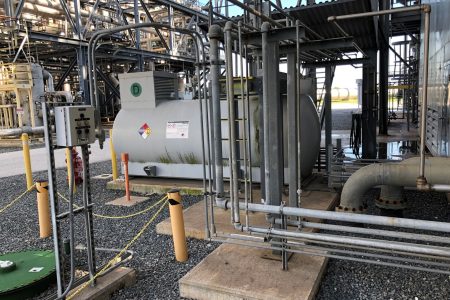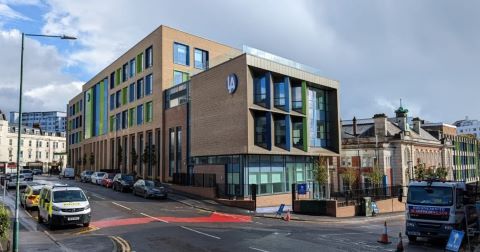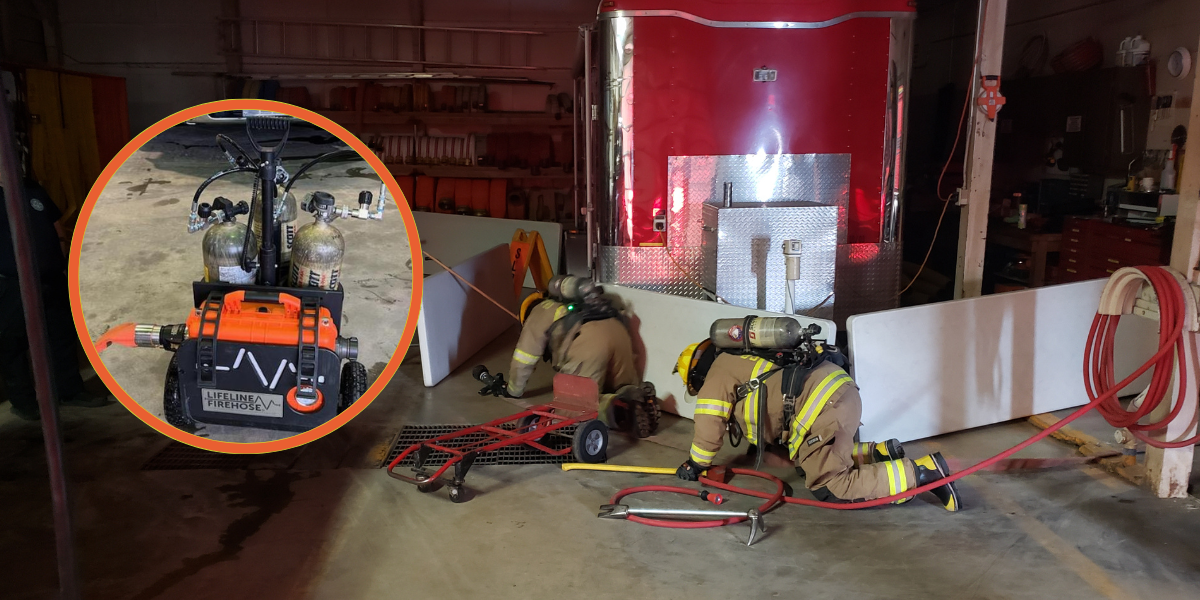 Lee Kaiser, PE, Chairperson of the Fire Suppression Systems Association (FSSA) Technical Committee, discusses the technical aspects of gaseous fire suppression exclusively for International Fire Buyer magazine.
Lee Kaiser, PE, Chairperson of the Fire Suppression Systems Association (FSSA) Technical Committee, discusses the technical aspects of gaseous fire suppression exclusively for International Fire Buyer magazine.
The activation of a gaseous fire suppression or extinguishing system at a facility requires a nuanced approach from trained responders. Gaseous fire suppression systems discharge compressed gasses of various types to extinguish fires in a room, specialty enclosure, equipment housing, or directly onto a piece of equipment. Water-based fire protection system activations are relatively common for fire department responses, but the routines which may be used for response to a water-based system activation may not be appropriate for response to a gaseous system release. In any fire jurisdiction, gaseous suppression systems are likely to be encountered less frequently than water-based systems. This article offers some considerations which may be particularly appropriate when responding to a fire where a gaseous agent system has deployed.
Basic safety considerations
Gaseous systems include clean agents, Halon 1301, hybrids, and carbon dioxide extinguishing systems. Clean agents are further subdivided into halocarbon agents and inert gas agents. Gaseous agent systems are most frequently installed to protect specific hazards, known as a “protected space,” which require a non-water-based agent for asset protection — therefore the addition of water by the fire department is generally undesirable. Gaseous systems primarily extinguish fires through heat absorption. The fire extinguishing gasses generally will remain in the enclosure for a period after the agent discharge ends.
The gas that remains in the hazard’s air presents a unique situation for arriving firefighters and for the building occupants. Carbon dioxide (CO2) presents a specific threat of asphyxiation for anyone in an area where the CO2 remains, both during and after the discharge. Although other agents such as clean agents, Halon, and hybrid media, in and of themselves present minimal real physical threat to occupants, toxic products of combustion from the fire as well as possible products of decomposition from halogenated agents may remain. Therefore, firefighters should enter the hazards wearing self-contained breathing apparatus (SCBA) to verify that fire has been extinguished and verify that no personnel were trapped by the fire. SCBA should be worn until the hazard has been adequately ventilated.
Assessing the hazard
Codes require signage to be present in spaces protected by gaseous fire suppression systems, identifying the specific agent installed. Firefighters should look for and read these signs. As part of the fire protection plan, facility managers should inform the local fire department of the presence of gaseous extinguishing systems in the facility. It is likewise advisable for firefighters to be informed of actions to be taken regarding ventilation of areas protected by gaseous systems.
Discharge warning strobes or beacons are typically installed to warn responders that a discharge inside a room has occurred. An active discharge beacon is a good reminder to use proper personal protective equipment when entering a space to investigate.
CO2 poses its own unique challenges since at fire extinguishing concentrations it will not support human life. Since CO2 is both colorless and odorless a dangerous concentration of CO2 is not readily detected by sensory perception. Some CO2 systems have odorizers installed on them, a special device which injects a distinctive odor into the CO2 gas, so the gas can be more readily detected. If responders smell a wintergreen odour when approaching an area where a CO2 system is present, they should retreat, secure the area against entry by unprotected personnel, and don SCBA before proceeding into the area.
When first responders arrive on scene, they generally will want to enter the space where the discharge occurred to verify that there is no active fire. SCBA should be worn when entering the space. A brief search of the room should occur to make sure there is no active fire. A thermal imaging camera may be used to identify any hot spots in the room. The information thus gathered may be useful in later determining if those “hot spots” were the ignition source.
Ventilating the protected space after discharge
After a gaseous agent discharge, before the room is safe for personnel without SCBA to enter, the space should be ventilated. Some rooms will have a dedicated exhaust fan to remove the agent and products of combustion from the room after a discharge, but this is not always the case. If exhaust fans are not present, the fire department can open doors and use ventilation fans to help clear the room. It is essential that the agent and combustion byproducts be ventilated to the outdoors, not merely moved to another indoor area of the facility. CO2 and halogenated agents are heavier than air and opening doors into the space can help the agent “leak” out of the room. But care should be taken that the agent and products of combustion do not leak into spaces at lower elevations. Spaces below the level of the protected space where the discharge occurred are likely to contain agent and should be ventilated with a fan to be made safe.
Specifically, CO2 tends to migrate to other areas after discharge. When ventilating after a CO2 discharge, use fresh air from outdoors, and pay special attention to spaces adjacent to and below the protected space to make sure people in other areas of the building are safe. It should be verified that the atmospheres in all affected spaces are clear of harmful gases and returned to normal oxygen levels before unprotected personnel are allowed to enter.
Restarting equipment
Many gaseous systems will be interlocked with equipment shutdowns to shut off fuel flow and reduce the presence of sustained electrical ignition sources. Ventilation systems may also be interlocked with the system. While it is typically not the fire department’s responsibility to restart equipment in the protected space, responders need to understand that the presence of a gaseous fire suppression system likely means that operations in the protected space will need to be restarted as soon as it is practical. This means that responders should investigate, ventilate, and make the room safe quickly so the process can be restarted by the appropriate person.
In some cases, the cause of a fire can be quickly determined and resolved so that operations within the protected space might be quickly resumed. In such instances, it may be advisable that a few responders remain on scene while electrical power is restarted, fuel is reintroduced, and operations are resumed just in case a fire reignites. In other cases, a more extensive review by fire investigators or facility operators may be required to determine and correct the cause of the fire. In the latter instance, it might be impractical for responders to remain onsite. There are many variables to consider on a case by case basis.
Some gaseous systems are not arranged to protect a whole room or enclosure, some are “local application” systems and only discharge on a piece of equipment or area where a fire is predicted to occur. Common production processes are often protected with local application systems. An example would be a metal rolling mill. In some of these mills, fires are relatively frequent with broken webs the common cause of fire. In such scenarios the plant operators will have a specified procedure for restarting the equipment and will likely not need responders to remain on the scene.
Bringing the fire protection system back online
After the system and the room are made safe, the fire protection system will need to be brought back online. Although this is not the responsibility of the fire department, fire prevention personnel should follow up with the system owner to make sure it is recharged, and the space is again protected. Depending on individual circumstances, operations may be halted until the fire protection system is brought back online. If operations are permitted to begin before the fire system is online, a fire watch should be maintained.
System recharges are often performed by a fire suppression systems contractor. The suppression tanks may be taken offsite to be filled and inspected, then brought back onsite and installed in the system. Once the tanks are in place, the contractor should ensure the system is operational and ready to work again. On sites where fires are expected frequently, there may be prefilled reserve tanks onsite ready to be placed in service immediately. Other times reserve tanks are connected to the system and can be made ready almost immediately through a main-reserve switchover process. Reserve tanks are a great option when the location of the tanks makes it difficult to refill the tanks in a reasonable amount of time.
Gaseous fire suppression systems are highly specialised and intended for fire extinguishment to save lives and livelihoods through the saving of property. They may be infrequently encountered by fire departments, however because of the critical nature of the equipment and operations these systems protect, a proper fire department response including the considerations set forth in this article, is essential.
Commentary: The Extinguishing Section of Euralarm, Guidance Document
The Extinguishing Section of Euralarm has published a guidance document explaining the differences between approved gaseous extinguishing systems and components. The aim of the guideline is to make any person involved in the choice of a gaseous extinguishing system aware of the major differences between quality marks and to help them make a decision based on clear and balanced information.
Gaseous fire extinguishing systems are a very effective way to protect critical hazards and high value assets, when it is important to have no collateral damage caused by the extinguishant or residues. For any kind of electric risk (Data Centre, IT rooms, Control rooms, Switchgear rooms, etc.) or very sensitive/valuable assets or materials (Art, Antiques, Rare books, etc.), they are often the first choice.
An additional factor is personal safety as many of these applications are occupied, either permanently or occasionally. The correct performance of a gaseous fire extinguishing system is therefore essential not only to quickly extinguish a fire but also to protect human life. It is important to understand how to assess the efficiency and reliability of a gaseous fire extinguishing system. Numerous quality marks are available to validate the compliance to rules and standards. However, it may be difficult for non-specialists such as end users to get a good understanding of the meaning of all these marks before selecting a particular gaseous extinguishing system.
The new guidance note of Euralarm aims on making any person involved in the choice of a system aware of the major differences between quality marks and to help them make a decision based on clear and balanced information.
Although the document specifically covers gaseous fire extinguishing systems only, the content may also be applicable to other fire extinguishing or fire prevention systems.
Commentary: Carl Stephen Patrick Hunter OBE is Chairman of Coltraco Ultrasonics
In July 2020, at the height of COVID19 in the USA, the USS Richard Bonhomme, an amphibious aircraft carrier, developed a 5-day fire during a maintenance interval. It injured 68 military and civil personnel.
The top US Navy acquisitions official said, “Anyone who steps aboard our ships must be ever vigilant about ensuring fire safety. I urge you to use the recent fire to ensure that our workspaces are clean, that unnecessary clutter is removed, that all fire safety measures are being followed and that there is unrestricted access to firefighting and damage control equipment.” Excellent, you may think. Regardless of the reason for the fire itself, a reason that the fire became uncontrolled … was because its fire suppression system had been shut down and its compartment doors left open. For maintenance.
For a gaseous extinguishing system to function, whether liquefied, such as CO2, NOVEC 1230 or FM-200 or non-liquefied, such as Nitrogen or Inergen, one needs two things: Firstly, sufficient contents to generate the design concentration required to extinguish the fire event, and secondly, compartmentation integrity, so that the extinguishing gas is contained within the space on actuation. Without either, the fire event risks escalation.
So how can one test that either exist? To cater for the contents, one can shut the system down, dismantle it, and weigh each cylinder of extinguishing gas. Then re-install each of them. There can 600 45KG cylinders on a commercial ship, 100 on an offshore platform. Hundreds in a Data Centre. It takes 2 licensed fire technicians 15 minutes to do this, per cylinder. On a good day. For the compartmentation integrity, one can pressurise the compartment space, either by air or water, and see where it leaks out. Neither works when the fire technicians are away from the asset for the other 364 days per annum.
This is how our industry has worked since gaseous systems were first developed. But here we are in our industry using gases for fire systems that are nearly 100, 60 and 30 years old, and we still test them inadequately. It is as if there has been no technological advance in any field other than our own. And the accidents keep coming. The fires keep hurting and destroying and our regulations gently modify themselves, all at a time of some of the highest-paced technological change the world has ever seen.
To stay up to date on the latest, trends, innovations, people news and company updates within the global fire market please register to receive our newsletter here.
Media contact
Rebecca Morpeth Spayne,
Editor, International Fire Buyer
Tel: +44 (0) 1622 823 922
Email: editor@firebuyer.com









